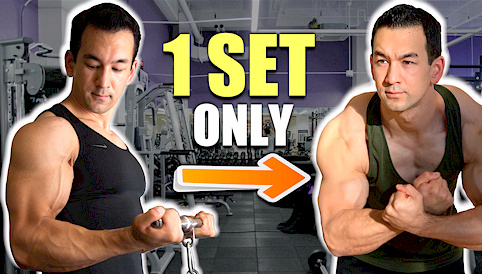HOW TO GAIN MUSCLE FASTER WITH REST-PAUSE TRAINING

If you want to spend less time in the gym while maintaining or even increasing the effectiveness of your workouts, rest-pause training might offer a solution.
In this article, you’ll discover what rest-pause training is, and how to get the most out of this technique. Let’s dive in!
What Is Rest-Pause Training?
Like it sounds, it’s a training technique that you can use to perform more lifting volume in a shorter time frame.
Here’s how it works:
- Perform as many reps as you can with a given weight
- Rest for 12 to 15 deep breaths
- Pick up the weight again and do as many reps as you can
- Rest for another 12 to 15 deep breaths
- Once again pick up the weight and do as many reps as possible
- Rest for a couple of minutes
- Repeat the cycle for the desired number of sets
In other words, you train to failure, use a short intra-set rest period to recharge, and then train to failure again.
How many series you do within a particular set is up to you, but most trainees go for two to four series each.
Here’s an example of what a rest-pause set with three series can look like for the bicep curl:
- 40 kg x 10 reps
- Rest for 12 to 15 deep breaths
- 40 kg x 4 reps
- Rest for 12 to 15 deep breaths
- 40 kg x 2 reps
- Rest 2 minutes before starting over.
In the example above, we assume that the trainee went to muscular failure on every set, meaning he or she tried to do as many reps as possible during each series.
As you can see, the number of reps that the trainee is able to do drops the further they get into their set. That’s normal due to the build-up of fatigue. When you’re ready to try this technique yourself, just try to do as many reps as possible each time you pick up the weight.
Why Is A Rest-Pause Style Beneficial?

One of the main benefits of rest-pause training is that you can do more training volume in a shorter time-frame.
For example, instead of doing three regular sets, you could turn it into one rest-pause set using three intra-set rest periods of ten seconds. This makes it a great technique for when you’re short on time.
Also, a rest-pause style reduces gym time without impairing the effectiveness of your workout.
Why’s that?
Generally, when training, only the last few reps of a given set are an effective trigger for muscle growth. This is often referred to as “effective reps” in the evidence-based fitness community.
You typically won’t trigger muscle growth unless your body has a good reason to adapt to the stimulus you place on it. As in, the easier the reps are, the less effective they are for muscle growth if they’re not near the point of muscular failure.
But once you get near muscular failure, the mechanical tension on your muscle fibers increases significantly, which triggers muscle building adaptations.
So, the idea with rest-pause training is that even though you do fewer total reps for an exercise, you can still do the same number of effective reps by reaching failure.
Thus, you can get the same or a very similar muscle building stimulus as you otherwise would but in a more efficient way. You just eliminate many of the “junk reps” and instead stay near the point of failure throughout the set.
That’s why rest-pause training shares many similarities to drop sets, though the difference is that you use the same weight throughout the entire set and use brief rest periods to recharge (instead of lowering the amount of weight you used in the first set and then immediately performing more reps).
As a result, rest-pause training allows you to do more quality reps overall compared to drop sets.as you get a brief pause to reset, there is less chance that your form breaks down, and you won’t stop the set just because of the “burn.”
Instead, you’ll stop because you truly hit muscular failure, which leads to better muscle growth. Also, you’ll also gain more strength since you won’t have to reduce the load.
The Scientific Literature On Rest-Pause Training
While the theory above sounds great, does the scientific data back up this training technique? Or is it just another training technique that sounds fancy but doesn’t live up to real-life expectations?
In a 2019 study published in the Journal of Strength and Conditioning Research, researchers compared the following two training protocols:
- A traditional protocol of three sets of six reps at 80% of one-repetition maximum (1RM).
- A rest-pause training protocol of performing a set at 80% of 1RM to failure, followed by as many extra sets with 20 second rest periods as needed to reach 18 reps.
After six weeks, the scientists compared the results between groups. The result? Both of them gained the same amount of strength, as assessed by checking their 1RM.
Further, both groups gained the same amount of muscle in their chest and arms, which indicates rest-pause training does not impair gains and thus is an effective way to reduce gym time.
Better yet, the rest-pause group saw a greater increase in both thigh muscle thickness and strength-endurance on the leg press. This data suggests rest-pause training is at least as effective as regular sets, and it may even be superior.

Who Should Use Rest-Pause Training?
Beginners best avoid advanced training techniques like rest-pause training as they can still maximize progress with regular sets. Doing rest-pause training wouldn’t enhance those results.
Since beginners often don’t have the proper coordination to use rest-pause training safely, they can’t maintain proper form under high amounts of fatigue, increasing injury risk.
As an intermediate or advanced trainee, you might benefit from rest-pause training. You could use it to reduce gym time without impairing the effectiveness of your workouts.
Now, you don’t have to use this training technique. You can still make excellent gains while using straight sets. But it can be a great addition to your exercise toolbox.
That said, rest-pause training is more stressful on the body than doing regular sets, and you don’t want to overtrain. It’s important to use this technique wisely, which we’ll discuss how to do in the next section.
How To Use Rest-Pause Training

There’s no “best” way to approach this technique as there are several different ways you can tackle it. The following three things are what I’d recommend for most people:
First, reserve rest-pause for isolation movements or machine-based exercises. Since you’re building up high amounts of fatigue with this technique, it is much harder to maintain proper exercise form on exercises that require a lot of coordination. Examples are big, compound movements like the squat, deadlift, and barbell overhead press.
Using rest-pause training for such complex movements can increase injury risk, so stick with isolation and machine movements if you’re going to incorporate it into your routine.
Second, don’t go overboard with rest-pause training. While it’s an effective way to train, it’s also more stressful on the body than regular sets. That’s important to keep in mind when setting up your training volume.
So, don’t replace all your current sets with rest-pause training. That’ll likely cause you to overtrain, produce inferior progress, and increase injury risk.
Instead, use rest-pause training as a complement to your regular workout routine. Or, if you want to use rest-pause training for most of your sets, do fewer total sets compared to what you otherwise would do.
Third, aim to do at least ten reps during the first attempt of each set. If you can’t reach that number, you can’t accumulate enough volume on the subsequent series.
I found that if I go to true failure, I get about half as many reps on the second attempt compared to the first, and 1-2 fewer reps on the third compared to the second attempt.
For example, I might go 12 reps, then six reps, then four reps. Or ten reps, five reps, three reps. The exact number you can reach isn’t that important. Just try to go (very close to) failure.
The Bottom Line
If you’re a beginner trainee, don’t worry about rest-pause training. You don’t need it to optimize progress, and it might even work against you.
But if you’re an intermediate or advanced trainee, rest-pause training is an excellent way to save time at the gym. And, it might even provide you with superior muscle growth as the literature suggests.
If you found this article helpful, make sure to sign up for your FREE custom fitness plan below...




